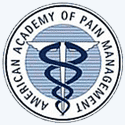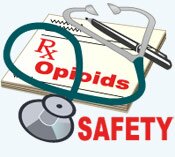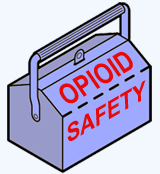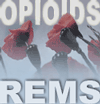Visit Pain-Topics.org
 Click here to see more information on opioids at Pain-Topics.org.
Click here to see more information on opioids at Pain-Topics.org.
Quick Reference
Partners for
Opioid Safety
Opioids911-Safety is
recommended by...

American Academy of
Pain Management
![]()
American Association
for the Treatment of
Opioid Dependence

American Chronic Pain
Association
![]()
American College of
Apothecaries
![]()
American Society for
Pain Management
Nursing
![]()
National Association
of Drug Diversion
Investigators

National Fibromyalgia
& Chronic Pain
Association
![]()
National Fibromyalgia
Association

Reflex Sympathetic
Dystrophy Syndrome
Association

The Foundation for
Peripheral Neuropathy

TNA-The Facial Pain
Association
Certifications
We comply with the
HONcode Standard
for trustworthy health
information.
![]()
Verify Here
WMA Certified

Verify Here
Opioids911-Safety has been independently developed with support provided in part by educational grants from...
Purdue Pharma L.P.
 Guidance for Healthcare Providers
Guidance for Healthcare Providers
Using Opioids911-Safety with Patients/Caregivers
- Introduction: Why Opioids911-Safety?
- Organization of Opioids911-Safety
- Opioids911-Safety Toolkit
- Steps for Using Opioids911-Safety with Patients/Caregivers
- Compliance with U.S. FDA Opioid-REMS Initiatives
- Permission for Clinical Use of Opioids911-Safety Materials
- How Opioids911-Safety Was Developed
A. Introduction: Why Opioids911-Safety?
This section of the Opioids911.org website provides guidance for all healthcare providers in using the opioid-safety education program with patients and their caregivers (family or friends who assist in their care). Why is this program so important?
As you know, opioid analgesics have demonstrated effectiveness in ameliorating many types of cancer- and noncancer-related pain, and the prescribing of opioids has increased dramatically during the past two decades. Along with that, however, there have been escalating incidences of opioid misuse, abuse, addiction, diversion, and overdose. Some authorities have proclaimed these safety problems a public health crisis and, unless they can be curtailed, the availability of opioid analgesics for patients in need may be further restricted by government agencies worldwide.
The burden of safety rests first with opioid prescribers, who must properly assess patients who might benefit, select appropriate opioid agents and dosing regimens, and monitor patient progress. Added training of healthcare providers in these clinical skills has been strongly advocated but this is beyond the purview of the Opioids911-Safety program.
Of equal importance for managing opioid-safety concerns, all authorities have stressed the need for more extensive and effective patient education, and this is the mission of Opioids911-Safety. Research evidence confirms that deficiencies of patient education in the past have resulted in unsafe practices. Furthermore, the prevention or identification of emergency situations by patients, including opioid overmedication and overdose, along with proper response if those crises do occur have been largely ignored by past educational efforts. In short, patients need to assume greater responsibility for opioid safety but they need appropriate education in order to do that.
Patient education on opioid safety, which also should involve their caregivers, begins at the point-of-care whenever an opioid prescription is written. This would include both short-term and long-term prescriptions since, whether the patient is provided a handful of opioids for acute pain or a month's supply for a chronic condition, most opioid-related risks are the same. Until now, however, healthcare providers have had little guidance on conducting patient education and few resources for this have been available. Opioids911-Safety is a first of its kind program focusing exclusively on providing educational resources and tools for healthcare providers - as well as patients, caregivers, and the public - on the safe use of opioid analgesics. The sections below describe this in more detail.
Back to Contents List for this Page
B. Organization of Opioids911-Safety
The Opioids911.org website has 4 instructional sections for patients/caregivers, each focusing on a general question that is followed by more specific subtopic questions. A 5th section addresses frequently asked questions (FAQs). Visitors can enter the educational program at any point, so there is redundancy of the most critical safety messages throughout the sections to accommodate this. If you have yet to briefly review the contents, click on the respective section questions below.
1. What are opioids?
![]() This section discusses in simple terms why opioid medications are prescribed and how they work to relieve pain. The different kinds of opioids are described and there is a link to a list of commonly prescribed opioid analgesics.
This section discusses in simple terms why opioid medications are prescribed and how they work to relieve pain. The different kinds of opioids are described and there is a link to a list of commonly prescribed opioid analgesics.
2. What are safety concerns with opioids?
 Six subtopics in this section address how to properly take opioid analgesics and how they can be harmful if misused, including discussions of opioid overmedication, overdose, tolerance, and addiction. Possible opioid side effects are described, including a link to a table presenting these in some detail. Restrictions on opioid prescribing and patient responsibilities for helping to ensure safe use are presented.
Six subtopics in this section address how to properly take opioid analgesics and how they can be harmful if misused, including discussions of opioid overmedication, overdose, tolerance, and addiction. Possible opioid side effects are described, including a link to a table presenting these in some detail. Restrictions on opioid prescribing and patient responsibilities for helping to ensure safe use are presented.
3. How can I prevent problems with opioids?
![]() Potential safety problems associated with opioids are discussed along with tips for avoiding them. The importance of keeping track of opioid medications and ways of safeguarding them are described, along with access to helpful resources. Safe disposal of opioid medications is stressed and instructions are provided for what to do if opioids are lost or stolen.
Potential safety problems associated with opioids are discussed along with tips for avoiding them. The importance of keeping track of opioid medications and ways of safeguarding them are described, along with access to helpful resources. Safe disposal of opioid medications is stressed and instructions are provided for what to do if opioids are lost or stolen.
4. What should be done in an emergency?
![]() This section focuses on identifying opioid overmedication and overdose situations, and what patients or their caregivers should do. Instructions are provided for emergency procedures while waiting for help to arrive. Guidance also is provided on identifying opioid withdrawal and managing self-tapering if access to opioid medication is cut off, such as during a disaster.
This section focuses on identifying opioid overmedication and overdose situations, and what patients or their caregivers should do. Instructions are provided for emergency procedures while waiting for help to arrive. Guidance also is provided on identifying opioid withdrawal and managing self-tapering if access to opioid medication is cut off, such as during a disaster.
5. Frequently Asked Questions about opioid safety.
![]() This section addresses common questions that patients and/or their caregivers may have about opioid analgesics. Although most of the answers are contained in the above 4 sections, this FAQ approach presents targeted information in response to typical questions from patients that may arise in clinical practice.
This section addresses common questions that patients and/or their caregivers may have about opioid analgesics. Although most of the answers are contained in the above 4 sections, this FAQ approach presents targeted information in response to typical questions from patients that may arise in clinical practice.
Back to Contents List for this Page
C. Opioids911-Safety Toolkit
 Educating patients can be a time consuming and daunting task unless easy-to-use resource tools are readily available. A vital part of the Opioids911-Safety mission is to provide the necessary tools to make patient/caregiver education at the point-of-care a routine component of everyday practice, and many of the tools can be effectively used by pharmacists at the point-of-purchase.
Educating patients can be a time consuming and daunting task unless easy-to-use resource tools are readily available. A vital part of the Opioids911-Safety mission is to provide the necessary tools to make patient/caregiver education at the point-of-care a routine component of everyday practice, and many of the tools can be effectively used by pharmacists at the point-of-purchase.
The toolkit section provides various resources for healthcare provider use, including a slide/flip-chart presentation, instructional handouts, and carefully constructed informational materials that can be selectively distributed to patients. There is a quiz that can be used to assess patient knowledge of vital opioid-safety practices and aids for healthcare providers wanting to develop an "Opioid Treatment Agreement." There also are links for healthcare providers to resources on proper opioid prescribing and addiction treatment.
![]() Go to the Opioid-Safety Resources Toolkit page <here>.
Go to the Opioid-Safety Resources Toolkit page <here>.
Back to Contents List for this Page
D. Steps for Using Opioids911-Safety Components with Patients/Caregivers
Opioid safety begins whenever a new prescription is written, and some patients and/or their caregivers also may need "refresher training" when opioid analgesic refills or revised prescriptions are given. A major concern is with risks associated with the long-term prescription of strong opioids for chronic pain. However, even patients provided a short-term prescription of opioids for acute pain - eg, following a surgical or dental procedure, after an injury, etc. - must know basic safety rules. Overmedication or overdose, and misuse, abuse, or theft of medication can happen just as easily with short-term prescriptions.
The amount of education and time invested at the point-of-care would differ for each situation. Here are the recommended components of Opioids911-Safety for (1) short-term and (2) long-term prescribing situations: (Links below are to the respective component in the Toolkit section <or, click here for the entire Toolkit section>).
1. Short-Term Opioid Prescription
- Provide patient/caregiver with Emergency Info Reminder Card <access here>.
- Provide Patient Information Handout <access here> and briefly review its contents with the patient and/or caregiver (available in English and Spanish)..
- Verbally caution patient/caregiver of serious opioid risks and advise them of the Opioids911.org website where they can get more information.
- [OPTIONAL] Provide patient a copy of the MedCard - Personal Health Information & Medications List <access here>.
2. Long-Term Opioid Prescription
- Provide patient/caregiver with Emergency Info Reminder Card <access here>.
- Have support staff conduct the Opioid Safety Presentation (slides or flip-chart version) <access here>.
- Provide Patient Information Handout <access here> to take home and briefly review its contents with the patient and/or caregiver (available in English and Spanish).
- Advise patients/caregivers of the Opioids911.org website where they can get more information.
- [OPTIONAL] Have patient (and caregiver if present) complete the Opioid Safety Quiz, <access here>.
- [OPTIONAL] Provide patient a copy of the MedCard - Personal Health Information & Medications List <access here>.
- [OPTIONAL] Provide the handout, Overdose Emergency Procedures - What to Do Until Help Comes <access here> (available in English and Spanish).
- [OPTIONAL] Have patient read and sign an Opioid Treatment Agreement <access here>.
Note: As requirements and components of opioid-REMS are developed in the U.S. (see below) these will be incorporated into the above recommendations.
Back to Contents List for this Page
E. Compliance with U.S. FDA Opioid-REMS Initiatives
![]() As part of its goal to ensure drug safety, the U.S. Food and Drug Administration (FDA) undertook an initiative in early 2009 requiring manufacturers to develop what are called "REMS" - Risk Evaluation and Mitigation Strategies - for certain opioid analgesics. These would entail a set of rules for the respective opioid products that healthcare providers and patients must follow to help reduce risks of opioid misuse, abuse, diversion, and overdose. Previously, FDA-approved REMS had been developed for select drugs, including certain opioid analgesics.
As part of its goal to ensure drug safety, the U.S. Food and Drug Administration (FDA) undertook an initiative in early 2009 requiring manufacturers to develop what are called "REMS" - Risk Evaluation and Mitigation Strategies - for certain opioid analgesics. These would entail a set of rules for the respective opioid products that healthcare providers and patients must follow to help reduce risks of opioid misuse, abuse, diversion, and overdose. Previously, FDA-approved REMS had been developed for select drugs, including certain opioid analgesics.
![]() See listings of ALL current FDA-approved REMS <here>.
See listings of ALL current FDA-approved REMS <here>.
![]() In March 2012, the Transmucosal Immediate Release Fentanyl (TIRF) Risk Evaluation and Mitigation Strategy (REMS) ACCESS program was instituted. This is an FDA-required program designed to ensure informed risk-benefit decisions before initiating treatment, and during treatment to ensure appropriate use of TIRF medicines. The purpose of TIRF REMS ACCESS is to mitigate risks of misuse, abuse, addiction, overdose, and serious complications due to errors in the use of TIRF medicines.
In March 2012, the Transmucosal Immediate Release Fentanyl (TIRF) Risk Evaluation and Mitigation Strategy (REMS) ACCESS program was instituted. This is an FDA-required program designed to ensure informed risk-benefit decisions before initiating treatment, and during treatment to ensure appropriate use of TIRF medicines. The purpose of TIRF REMS ACCESS is to mitigate risks of misuse, abuse, addiction, overdose, and serious complications due to errors in the use of TIRF medicines.
![]() The TIRF REMS ACCESS program is available <here>.
The TIRF REMS ACCESS program is available <here>.
 In July 2012, the Food and Drug Administration (FDA) announced finalization of a new ER/LA-Opioid Analgesic REMS that will apply to all extended-release (ER) and long-acting (LA) opioid medications. A first part of this REMS program focuses on educating prescribers about proper pain management, patient selection and monitoring, and other aspects of opioid analgesic safety pertaining to these products..
In July 2012, the Food and Drug Administration (FDA) announced finalization of a new ER/LA-Opioid Analgesic REMS that will apply to all extended-release (ER) and long-acting (LA) opioid medications. A first part of this REMS program focuses on educating prescribers about proper pain management, patient selection and monitoring, and other aspects of opioid analgesic safety pertaining to these products..
![]() The list of opioid products coming under this new REMS is available <here>.
The list of opioid products coming under this new REMS is available <here>.
Second, the new REMS requires prescribers to improve patient awareness about how to use these drugs safely. To achieve this, the FDA requires that patient education materials are made available at the point-of-care, as well as Medication Guides to be distributed by prescribers (voluntarily) and with each product at pharmacies (as mandated by regulation).
According to the new ER/LA-Opioid Analgesic REMS, patient (and caregiver) education and counseling must include at least the following elements:
- How to take opioids properly, including: a) adherence to the dosing regimen, b) risks from breaking, chewing, crushing certain products, c) identifying symptoms of overdose.
- Reporting adverse effects of opioids.
- Dangers of concomitant use of other CNS depressants, alcohol, or illegal drugs.
- Discontinuation of opioid analgesics.
- Risks associated with sharing of prescription opioids.
- Proper storage in the household, including avoiding accidental exposure.
- Avoiding unsafe exposure by preventing theft and proper disposal.
- Purpose and content of a Patient Treatment Agreement.
- Links to Web sites with more information about topics 1 through 8.
This Opioids911-Safety program addresses all of the above requirements, plus…
- Opioids911 applies to both extended-release/long-acting opioids under the REMS and short-acting/immediate-release opioid analgesics.
- Distinguishing between addiction and physical dependence (tolerance, withdrawal).
- Signs/symptoms of opioid withdrawal, and what to do.
- How to identify symptoms of opioid overmedication, as well as overdose.
- Instruction on how patients/caregivers can best manage emergencies related to opioids: eg, overmedication or life-threatening overdose, accidental opioid poisoning in others, and emergency tapering.
Therefore, Opioids911-Safety contains the instructional content, tools, and resources necessary for healthcare providers to maintain compliance with the patient and caregiver education requirements of the ER/LA-Opioid Analgesic REMS. Also see Part D <above> for how to use this program.
![]() More info can be found at the official ER/LA-Opioid REMS Website <here>.
More info can be found at the official ER/LA-Opioid REMS Website <here>.
Note: Opioids911-Safety will be updated to reflect any further approaches to patient education as required by the FDA-approved Opioid-REMS.
Back to Contents List for this Page
F. Permission for Clinical Use of Opioids911-Safety Resources
![]() Contents of this website and associated program materials are copyrighted by Opioids911-Safety, a project of Pain Treatment Topics, and permission for use by healthcare providers is granted under a Creative Commons Attribution-NonCommercial 3.0 Unported License <info here>. Creative Commons is a nonprofit entity dedicated to making it easier for people to share and use the work of others, consistent with the rules of copyright.
Contents of this website and associated program materials are copyrighted by Opioids911-Safety, a project of Pain Treatment Topics, and permission for use by healthcare providers is granted under a Creative Commons Attribution-NonCommercial 3.0 Unported License <info here>. Creative Commons is a nonprofit entity dedicated to making it easier for people to share and use the work of others, consistent with the rules of copyright.
The granted permission means the following:
- You are free to download, reproduce, and distribute contents of Opioids911-Safety as a clinical component of staff, patient, and caregiver information and education.
- However, you must properly attribute the materials by including the original copyright notice as it appears on the website or in downloaded materials.
- If necessary, you may adapt Opioids911-Safety materials to your particular clinical needs, such as adding your contact information or minor modifications of text. In such cases, you may not imply that Opioids911-Safety endorses or approves of any changes that are made.
- Commercial use is prohibited without prior permission, including use of any Opioids911-Safety contents in electronic media (eg, websites, blogs), publication for mass distribution in journals, magazines, books, or other documents, and other uses of a commercial nature whether or not a fee is charged. For commercial permissions contact Admin@Opioids911.org.
Back to Contents List for this Page
G. How Opioids911-Safety Was Developed
Opioids911-Safety was developed as an independent, noncommercial offering of Pain Treatment Topics <see ‘About Us' here>. All contents are based on available best evidence from extensive resources published by medical journals, government agencies, associations, and other sources that were deemed to be valid and reliable <resource list here>. Contents also were reviewed by the Opioids911 panel of medical experts <biographies here>.
An important criteria in developing Opioids911-Safety was to be in full compliance with all standards regarding the appropriate and accurate communication of health-related information to the public. This includes compliance with HONcode standards for reliable health information on the Internet and Web Médica Acreditada (WMA) standards of the European Union. Program contents also comply with the standards of other certifying organizations and the latest U.S. FDA guidance for presenting consumer-oriented information via the Internet.
Special attention was devoted to creating a format that would be interesting, easy to read and understand, and motivate specific safety-related behaviors by patients and caregivers. Design and construction of the Opioids911.org website follows strict criterial for user-friendliness, ease of navigation, and accessibility as required by Section 508 Standards of the U.S. Workforce Rehabilitation Act <details here>. These standards incorporate adherence to the Web Accessibility Initiative of the World Wide Web Consortium (W3C), which has specified a set of Web Content Accessibility Guidelines <available here>.




